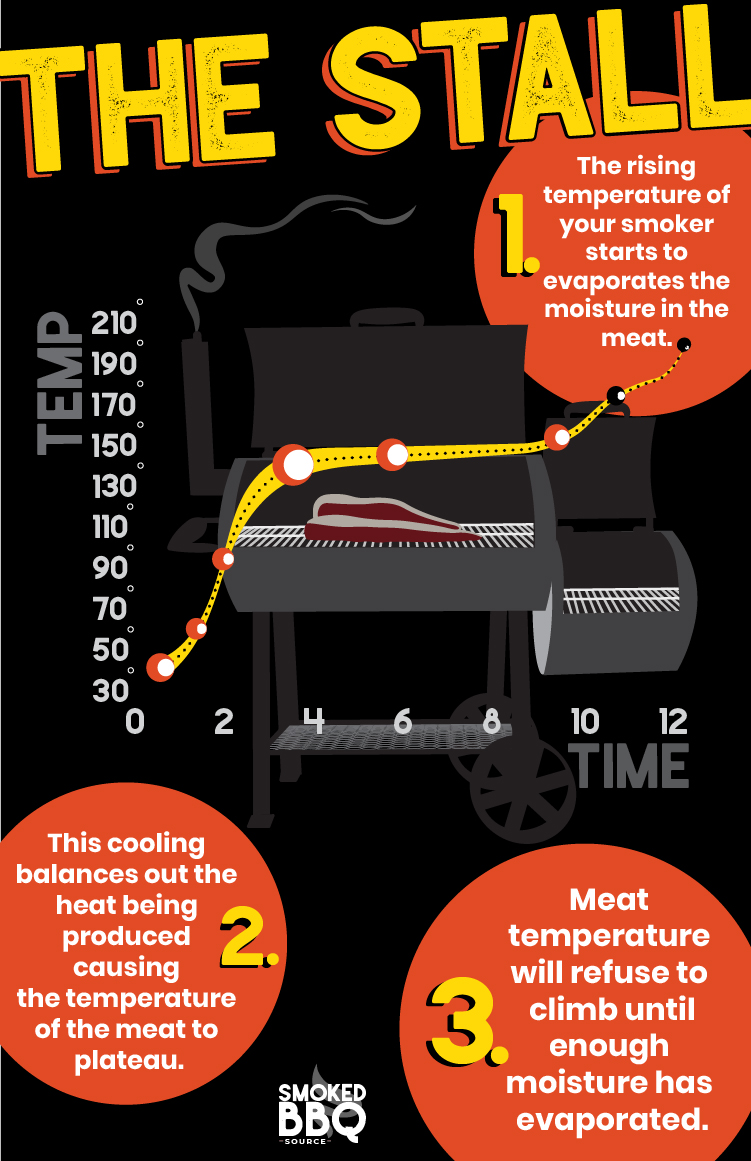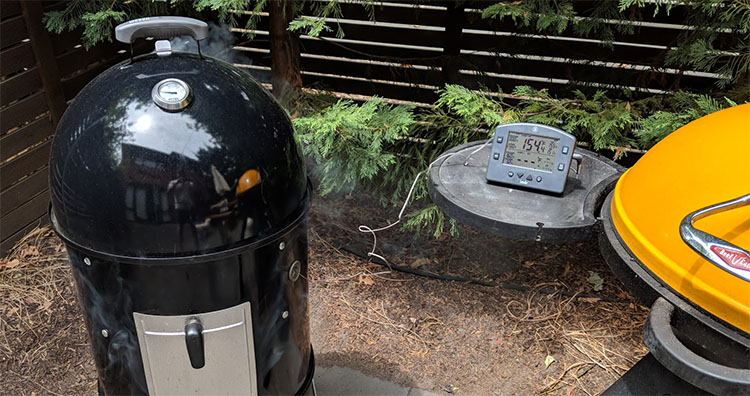Let me paint a picture for you, one that a lot of pitmasters will be depressingly familiar with.
It’s the weekend. You’ve successfully handled a prime beef brisket or pork shoulder, and you’ve extended an invitation to your loved ones to share in your enjoyment.
After lighting your smoker and applying the Minion Method to maintain the pit’s temperature, you relax and sip a well-earned beer.
For the first few hours, the meat temperature rises, giving you a warm sense of achievement, and then it flatlines. Perhaps, to your horror, the meat even starts to drop in temperature.
All eyes are on you, your guests are growing hungry, and the meat you promised is actually moving away from that magical 203°F mark.
The good news is that there is a solution for the chemistry problem; the BBQ stall is not a punishment meted out by the Pit Gods.
In this article, we’ll go over what causes the BBQ stall and your best options to beat it
Ah, the Thanksgiving turkey. A centerpiece of the holiday feast, a symbol of abundance, and a culinary challenge for many home cooks. But what happens when your carefully seasoned, meticulously prepped turkey seems to stall in the smoker, its internal temperature refusing to budge? Fear not, fellow turkey enthusiasts, for the stall is a natural phenomenon, and with a little understanding and patience, you can overcome it and achieve a perfectly cooked, juicy bird.
Understanding the Stall: A Tale of Physics and Proteins
The stall, also known as the plateau or the zone, occurs when smoking or cooking larger cuts of meat at low temperatures for extended periods. It typically happens when the internal temperature of the meat reaches between 150°F and 170°F and seems to stop rising. This can be a frustrating experience, especially for those new to smoking, but it’s important to remember that the stall is not a sign of failure; it’s simply a phase in the cooking process.
So, what causes this temperature plateau? The answer lies in the science of cooking. As the meat heats up, the moisture within its cells evaporates, creating a layer of cool vapor around the meat. This vapor acts as an insulator, preventing the meat’s temperature from rising further until the vapor itself heats up and dissipates.
Additionally during the stall, complex proteins within the meat begin to break down, a process that requires energy and can temporarily slow down the temperature increase.
Navigating the Stall: Patience and Persistence Are Key
While the stall can be a test of patience, it’s crucial not to panic or try to rush the process. Here are some tips for navigating the stall and ensuring a perfectly cooked turkey:
- Don’t open the smoker or oven frequently: Every time you open the door, heat escapes, prolonging the stall. Trust the process and maintain a steady temperature inside your smoker or oven.
- Maintain a consistent temperature: Aim for a smoker temperature of around 225°F to 250°F. Consistent heat will help the turkey cook evenly and overcome the stall.
- Wrap the turkey in foil or butcher paper: This helps trap moisture and prevent the turkey from drying out during the stall.
- Baste the turkey regularly: Basting with a mixture of melted butter, herbs, and spices adds flavor and helps keep the skin moist.
- Be patient: The stall can last anywhere from 30 minutes to a couple of hours. Don’t be tempted to crank up the heat or remove the turkey prematurely.
- Use a reliable thermometer: An accurate thermometer is essential for monitoring the internal temperature of the turkey and determining when it’s done.
Embracing the Stall: A Time for Flavor Enhancement
While the stall may seem like an obstacle, it can actually be an opportunity to enhance the flavor of your turkey. Here are some ways to make the most of the stall:
- Add more wood chips or chunks to the smoker: This will infuse the turkey with additional smoke flavor.
- Baste the turkey with a flavorful glaze or marinade: This will add moisture and complexity to the finished product.
- Inject the turkey with a flavorful brine or marinade: This will help to keep the meat moist and tender.
Overcoming the Stall: A Triumph of Culinary Patience
By understanding the stall, maintaining a consistent temperature, and using patience and persistence, you can overcome this culinary hurdle and achieve a perfectly cooked, juicy turkey Remember, the stall is not a sign of failure; it’s simply a phase in the cooking process. Embrace the stall as an opportunity to enhance the flavor of your turkey and enjoy the satisfaction of conquering this culinary challenge
Additional Tips for Smoking Turkey:
- Start with a thawed turkey: A frozen turkey will take much longer to cook and may not cook evenly.
- Remove the giblets and neck: These can be used to make gravy or stock, but they should be removed before smoking the turkey.
- Pat the turkey dry before seasoning: This will help the seasoning adhere to the skin.
- Use a dry rub or brine to season the turkey: This will help to keep the meat moist and flavorful.
- Rest the turkey before carving: This allows the juices to redistribute, resulting in a more tender and flavorful bird.
Smoking a turkey may seem daunting, but with a little understanding and patience, it can be a rewarding experience. By overcoming the stall and following these tips, you can achieve a perfectly cooked, juicy turkey that will be the star of your Thanksgiving feast. So, fire up your smoker, embrace the stall, and prepare to enjoy the delicious rewards of your culinary efforts.
What is the barbecue stall, and why does it happen?
When you put a big piece of meat, like a brisket, on the smoker, and after two or three hours, the meat reaches a temperature of about 150°F and stops rising, you have a barbecue stand.
The stall can last for up to six hours before the temperature starts rising again.
There are a fair number of different theories floating around about why certain meats stall during cooking.

Fortunately, the teams at Genuine Ideas and Amazing Ribs chose to carry out a number of tests to pinpoint the exact cause of the stall.
Their test showed that the most likely culprit for the stall was evaporative cooling.
In other words, your brisket or shoulder is sweating just as much as you are because your meat isn’t reaching room temperature.
After about three hours of cooking, the rising temperature of your smoker evaporates the moisture in the meat.
This evaporative cooling balances out the heat being produced by your smoker’s fuel, causing the temperature of the meat to plateau, usually at around 150°F.
Sweating is a result of the same process that keeps your body cool on hot days.
When enough moisture has evaporated to prevent evaporative cooling from offsetting the heat from your smoker, the temperature of the meat will then refuse to rise again.
Our smoking times and temps chart has average smoke times for all the best meats to smoke.
Free Chart: You can access our smoking times and temperatures chart at any time by downloading a free copy of it.
How long can the stall last?
The stall for brisket typically opens two to three hours after the meat reaches an internal temperature of about 150°F. The meat may remain in the stall for up to seven hours before its temperature begins to rise once more.
Once the temperature does start to rise, it can go quickly. A brisket typically reaches its ultimate temperature of 203°F in an hour or two.

Moisture evaporating from the meat will then stall its temperature out, with the stall moving from the outer surface to the center.
This stall will last until your smoker’s heat energy is no longer balanced by the amount of moisture that has evaporated. The temperature of your meat will then start to climb again.
The length of your stall is hard to predict, as it depends on a large number of variables:
- The cut of meat you are attempting to cook should be the right size. A larger piece will hold more water and cook more slowly. The surface area of the meat also contributes. More surface area will cause more moisture to evaporate.
- Your smoker’s design: Smokers with more airflow promote evaporation A fan may even be included in some pellet smokers, which may help them run their stalls shorter. Additionally, electric smokers typically have tight seals, which lessen evaporative cooling.
- Using a water pan: Water pans maintain a high level of humidity within your smoker, reducing some of the moisture that is lost while cooking. They also enhance the smoky flavor of your meat by allowing water to combine with the smoker on its surface. The drawback is that they lengthen the meat’s stall time by increasing the moisture content of its surface.
- Using a wet mop, brush, or spritz – Many pitmasters use a range of methods to add moisture to their meat’s surface as it cooks. This adds to the stall and slows down the cooking time while offering the same advantages as the water pan.
With all these variables, it’s hard to put an exact time on how long a stall might take.
According to Murphys Law, the stall will probably take about an hour longer than you estimated.
In some really extreme cases, I’ve heard of brisket stalls lasting for over 10 hours!
AWESOME Smoked Turkey Recipe For Beginners!
FAQ
What temp does turkey stall when smoking?
What if my turkey is cooking too fast in the smoker?
What happens if you smoke a turkey too long?
How do you keep turkey from drying out in the smoker?
